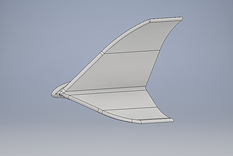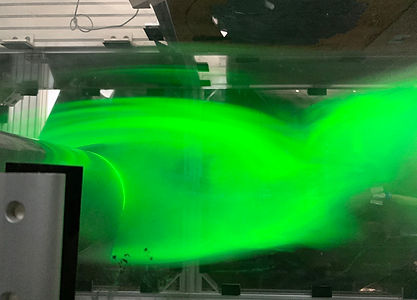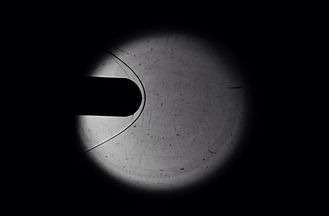Aerospace Engineering
Wind Tunnel: Subsonic
Winglet Lab
Designed (SolidWorks) and manufactured (3D printed) winglets. Analyzed Pressure distribution and Lift/Drag ratio of a wing with and without the winglets using Matlab. Images of the designed winglets and Lift/Drag results included. Full lab reports provided to the right of images. Course: Aerospace Fluid Mechanics.
-Braden and Patrick, different lab teams
Patrick's Team's Winglet


Braden's Team's Winglet:




Cylinder Lab
Analyzed airflow past a cylinder using Matlab. A trip-strip was then added to the bottom half of the cylinder and its effects on pressure and boundary layer was observed. Images of the cylinder in the wind tunnel and a pressure graph included below. Course: Aerospace Fluid Mechanics.
-Braden and Patrick, different lab teams


Wind Tunnel: Supersonic
Shock Wave Lab
Observed an oblique shock wave in a supersonic wind tunnel. Captured image of the shock provided below. Full lab report due next week. Course: Aerospace Gas Dynamics and Heat Transfer.
-Braden and Patrick, different lab teams

Computational Fluid Dynamics
2D Airfoil CFD Lab
In this fluid mechanics lab, an RAE2822 airfoil was CFD tested using STAR-CCM+ software. Freestream flow characteristics tested include Reynold's number, viscous versus inviscid flows, and Mach number. Pressure as well as contour plots allowed for comparisons between test cases and thus flow conditions. The lab gave insight into the acceleration of flow over the airfoil, airfoil wake vortices, the effect of Reynold’s number on the free stream air flow, and finally served as an introduction to computational fluid dynamics.
A screenshot of a contour plot of the test cases is shown below. This test case includes an angle of attack of 2.92 degrees, turbulent flow at 252 m/s, a mach number of 0.75, and a Reynold’s number of 6.5 x 10^6. The air is transonic until it accelerates over the airfoil, briefly becoming supersonic. Zooming in on the top of the airfoil, one can see the colors transition to blue, indicating a slowing flow. Right next to the airfoil, the color of the flow is dark blue, indicating the boundary layer. The slower flow below the airfoil gives insight to the high pressure area under the airfoil, generating lift.
-Patrick and Braden, lab done individually

Numerical Analysis
Runge-Kutta Method
Implemented the workhorse of MATLAB’s ode45 function: the fourth order Runge-Kutta differential equation solver. Matlab program included below.
-Patrick and Braden, lab done individually
Other Matlab Programs
Gaussian Elimination, LU Factorization, Jacobi Iteration, Interpolating Functions, Interpolation Error, Least Squares, Newton‐Cotes Formulas, Analysis of Initial Value Problem Solvers, The Fourier Transformation, QR Algorithm, and Singular Value Decomposition. Programs available upon request.
-Patrick and Braden, assignments done individually
Aeronautical Engineering
Aircraft Dynamics
Derived the total aircraft lift and pitching moment, taking into account the wing, body, and tail flow interactions. Derived and calculated aerodynamic center, mean aerodynamic chord, neutral point, lift slope, tail volume coefficient, and static margin, for stick fixed and stick free configurations. Analyzed balance and stability conditions.
-Patrick and Braden, collaborative
Fundamentals of Controls
Derived the angular momentum of a system consisting of multiple rigid bodies.
Applied Euler’s equations of motion to determine the rotational dynamics of a system.
Studied the stability of a dynamical system using its state equation and Lyapunov and LaSalle stability theorems.
-Patrick and Braden, collaborative
Winter and Spring Quarter Courses
Patrick Schneider
Winter 2019
Aerospace Structural Analysis, Aerospace Gas Dynamics & Heat Transfer, Aircraft Dynamics & Controls, and Computing Ethics
Spring 2019
Aerospace Structural Analysis II, Supersonic & Hypersonic Aerodynamics, Experimental Aerodynamics, Electric Circuit Theory, and Aerospace Systems Engineering
Braden Coates
Winter 2019
Aerospace Structural Analysis, Aerospace Gas Dynamics & Heat Transfer, and Aircraft Dynamics & Controls
Spring 2019
Aerospace Structural Analysis II, Supersonic & Hypersonic Aerodynamics, Experimental Aerodynamics, and Aerospace Systems Engineering
